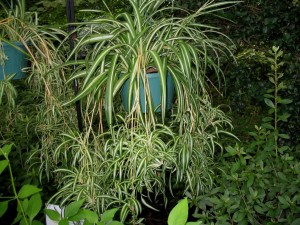by Jes-c Brandt, Somervell County Master Gardener Intern
My interest in gardening didn’t start in a garden, but with a house plant. It was a spider plant, to be specific. When I moved from Massachusetts four years ago, my boss gave me a little plantlet that her own spider plant had put off. Since then, that plantlet has grown into a great big spider plant that reproduces plenty of its own.
Now that spider plant, along with being beautiful and easy to care for, represents something I love about gardening: sharing. I can’t count the number of little spider plants I’ve potted for friends and family, and likewise, I can’t count the number of other plants I’ve received from fellow gardeners.
When I think of gardening, I think of childhood summers when our kitchen counter was filled with zucchini and tomatoes from our neighbors’ overflowing harvest. I think of my mom, gathered with her friends, shucking countless ears of corn for each of them to stock up their freezers. I think of a fresh bouquet of flowers shared with a friend. I think of jars of jelly, applesauce and salsa being shared amongst family, when there is more than enough to go around.
There are many ways for a gardener to share her passion, be it sharing the harvest or helping to propagate new plants. Spider plants, like many houseplants, easily propagate through asexual reproduction, producing a new plant that is genetically identical to the first. A spider plantlet can begin to root in either water or soil. Personally, I prefer to use soil, leaving the plantlet connected to the parent plant by the shoot until it has had a chance to take root. Once it’s rooted, snip the shoot, and the new plant is ready to be shared.
If you have any questions about propagating plants of your own, contact the Somervell County Master Gardeners.